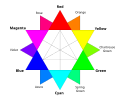Journals
The preeminent scholarly journal publishing research papers in color science is Color Research and Application , [1] started in 1975 by founding editor-in-chief Fred Billmeyer, along with Gunter Wyszecki, Michael Pointer and Rolf Kuehni, as a successor to the Journal of Colour (1964–1974). Previously most color science work had been split between journals with broader or partially overlapping focus such as the Journal of the Optical Society of America (JOSA), Photographic Science and Engineering (1957–1984), and the Journal of the Society of Dyers and Colourists (renamed Coloration Technology in 2001).
Other journals where color science papers are published include the Journal of Imaging Science & Technology , the Journal of Perceptual Imaging , the Journal of the International Colour Association (JAIC), the Journal of the Color Science Association of Japan , Applied Optics , and the Journal of Vision .
This page is based on this
Wikipedia article Text is available under the
CC BY-SA 4.0 license; additional terms may apply.
Images, videos and audio are available under their respective licenses.

